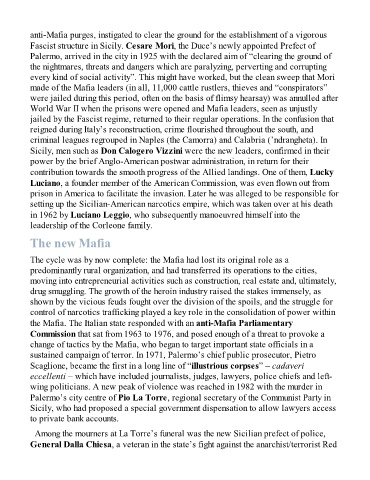Page 578 - The Rough Guide of Sicily
P. 578
anti-Mafia purges, instigated to clear the ground for the establishment of a vigorous
Fascist structure in Sicily. Cesare Mori, the Duce’s newly appointed Prefect of
Palermo, arrived in the city in 1925 with the declared aim of “clearing the ground of
the nightmares, threats and dangers which are paralyzing, perverting and corrupting
every kind of social activity”. This might have worked, but the clean sweep that Mori
made of the Mafia leaders (in all, 11,000 cattle rustlers, thieves and “conspirators”
were jailed during this period, often on the basis of flimsy hearsay) was annulled after
World War II when the prisons were opened and Mafia leaders, seen as unjustly
jailed by the Fascist regime, returned to their regular operations. In the confusion that
reigned during Italy’s reconstruction, crime flourished throughout the south, and
criminal leagues regrouped in Naples (the Camorra) and Calabria (’ndrangheta). In
Sicily, men such as Don Calogero Vizzini were the new leaders, confirmed in their
power by the brief Anglo-American postwar administration, in return for their
contribution towards the smooth progress of the Allied landings. One of them, Lucky
Luciano, a founder member of the American Commission, was even flown out from
prison in America to facilitate the invasion. Later he was alleged to be responsible for
setting up the Sicilian-American narcotics empire, which was taken over at his death
in 1962 by Luciano Leggio, who subsequently manoeuvred himself into the
leadership of the Corleone family.
The new Mafia
The cycle was by now complete: the Mafia had lost its original role as a
predominantly rural organization, and had transferred its operations to the cities,
moving into entrepreneurial activities such as construction, real estate and, ultimately,
drug smuggling. The growth of the heroin industry raised the stakes immensely, as
shown by the vicious feuds fought over the division of the spoils, and the struggle for
control of narcotics trafficking played a key role in the consolidation of power within
the Mafia. The Italian state responded with an anti-Mafia Parliamentary
Commission that sat from 1963 to 1976, and posed enough of a threat to provoke a
change of tactics by the Mafia, who began to target important state officials in a
sustained campaign of terror. In 1971, Palermo’s chief public prosecutor, Pietro
Scaglione, became the first in a long line of “illustrious corpses” – cadaveri
eccellenti – which have included journalists, judges, lawyers, police chiefs and left-
wing politicians. A new peak of violence was reached in 1982 with the murder in
Palermo’s city centre of Pio La Torre, regional secretary of the Communist Party in
Sicily, who had proposed a special government dispensation to allow lawyers access
to private bank accounts.
Among the mourners at La Torre’s funeral was the new Sicilian prefect of police,
General Dalla Chiesa, a veteran in the state’s fight against the anarchist/terrorist Red

